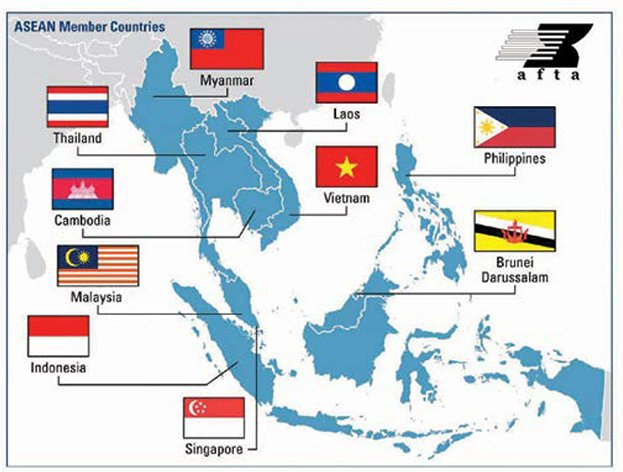Focus: GS-II International Relations
Why in news?
Indian Minister of Commerce and Industry & Railways co-chaired the 17th ASEAN-India Economic Ministers Consultations held virtually on 2020.
Details
- The meeting was attended by the Trade Ministers of all the 10 ASEAN countries.
- The Ministers reaffirmed their commitment to take collective actions in mitigating the economic impact of the pandemic and resolved to ensure macroeconomic and financial stability and resilient supply chain connectivity, particularly the unimpeded flow of essential goods and medicines in the region, in compliance with the WTO rules.
- The Ministers’ discussion centred on the review of the ASEAN India Trade in Goods Agreement (AITIGA).
- The report of the ASEAN India Business Council (AIBC) was placed before the Ministers and the report has recommended that the AITIGA be reviewed for mutual benefit.
- The Ministers from India and ASEAN countries instructed the senior officials to start the discussions to determine the scope of the review at the earliest to, inter-alia, make the Free Trade Agreement more user-friendly, simple, and trade facilitative for businesses.
ASEAN India-Business Council (AIBC) was set up in 2003 as a forum to bring key private sector players from India and the ASEAN countries on a single platform for business networking and sharing of ideas.
Association of Southeast Asian Nations (ASEAN)
The Association of Southeast Asian Nations (ASEAN) is a regional intergovernmental organization comprising Ten Countries in Southeast Asia.
Members of ASEAN
- Indonesia
- Malaysia
- Philippines
- Singapore
- Thailand
- Brunei
- Vietnam
- Laos
- Myanmar
- Cambodia

ASEAN’s Objectives:
- To promote intergovernmental cooperation and facilitates economic, political, security, military, educational, and sociocultural integration among its members and other countries in Asia.
- To maintain close and beneficial cooperation with existing international and regional organisations.
- To promote regional peace and stability through abiding respect for justice and the rule of law and adherence to the principles of the United Nations Charter.
- To accelerate economic growth, social progress and cultural development for a prosperous and peaceful community of Southeast Asian Nations.
A major partner of Shanghai Cooperation Organisation, ASEAN maintains a global network of alliances and dialogue partners and is considered by many as the central union for cooperation in Asia-Pacific.
- The motto of ASEAN is “One Vision, One Identity, One Community”.
- ASEAN is headquartered in Jakarta, Indonesia.
- 8th August is observed as ASEAN Day.
- In 1967 ASEAN was established with the signing of the ASEAN Declaration (Bangkok Declaration) by its founding fathers: Indonesia, Malaysia, Philippines, Singapore and Thailand.
- Chairmanship of ASEAN rotates annually, based on the alphabetical order of the English names of Member States.
- ASEAN is the 3rd largest market in the world – larger than EU and North American markets.
ASEAN Plus Three
ASEAN Plus Three is a forum that functions as a coordinator of co-operation between the ASEAN and the three East Asian nations of China, South Korea, and Japan.
ASEAN Plus Six
- further integration to improve existing ties of Southeast Asia was done by the larger East Asia Summit (EAS), which included ASEAN Plus Three as well as India, Australia, and New Zealand.
- The group became ASEAN Plus Six with Australia, New Zealand, and India, and stands as the linchpin of Asia Pacific’s economic, political, security, socio-cultural architecture, as well as the global economy.
- This group acted as a prerequisite for the planned East Asia Community which was supposedly patterned after the European Community (now transformed into the European Union).
ASEAN-India Trade in Goods Agreement (AITIGA)
- The ASEAN-India Trade in Goods Agreement was signed and entered into force in 2010.
- Under the Agreement, ASEAN Member States and India have agreed to open their respective markets by progressively reducing and eliminating duties on more than 75% coverage of goods.
ASEAN-India Trade in Services Agreement (AITISA)
- The ASEAN-India Trade in Services Agreement was signed in 2014.
- It contains provisions on transparency, domestic regulations, recognition, market access, national treatment and dispute settlement.
ASEAN-India Investment Agreement (AIIA)
- The ASEAN-India Investment Agreement was signed in 2014.
- The Investment Agreement stipulates protection of investment to ensure fair and equitable treatment for investors, non-discriminatory treatment in expropriation or nationalisation as well as fair compensation.
ASEAN-India Free Trade Area (AIFTA)
- The ASEAN–India Free Trade Area (AIFTA) is a free trade area among the ten member states of the Association of Southeast Asian Nations (ASEAN) and India.
- The free trade area came into effect in 2010.
- The ASEAN–India Free Area emerged from a mutual interest of both parties to expand their economic ties in the Asia-Pacific region.
- India’s Look East policy was reciprocated by similar interests of many ASEAN countries to expand their interactions westward.
- The signing of the ASEAN-India Trade in Goods Agreement paves the way for the creation of one of the world’s largest FTAs – a market of almost 1.8 billion people with a combined GDP of US $ 2.8 trillion.
- The AIFTA will see tariff liberalisation of over 90% of products traded between the two dynamic regions, including the so-called “special products,” such as palm oil (crude and refined), coffee, black tea and pepper.





